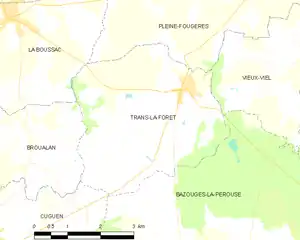Battle of Trans-la-Forêt
The Battle of Trans-la-Fôret was fought on 1 August 939 between the occupying Norsemen and the Bretons, led by the joint army of Alan II, Hugh II of Maine, and Judicael Berengar.[1][2][3]
| Battle of Trans-la-Fôret | |||||||
|---|---|---|---|---|---|---|---|
 Location of Trans-la-Forêt within Brittany region | |||||||
| |||||||
| Belligerents | |||||||
|
Bretons Franks | Vikings | ||||||
| Commanders and leaders | |||||||
|
Alan II Judicael Berengar Hugh II of Maine | unknown | ||||||
Political landscape
Throughout the early 900's the region was in a state of flux:
- In 931 the Norsemen assembled a army on the Loire to attack the Franks. the Bretons seized this opportunity and rebelled. The Norsemen appear to have been taken by surprise but a counterattack ensured Brittany was reconquered.
- In 936 following the death of Rudolph and Louis IV's ascending the throne of West Francia, the Bretons attempted to divest themselves from Frankish hegemony this time and rose in revolt.
Receiving support from the Anglo-Saxon King Athelstan, the Bretons spread their rebellion throughout the peninsula and this brought them into direct confrontation with Norsemen colonists living within the region.[4][5]
Through the course of three years, the campaign against the Norsemen reached a conclusion at Trans-la-Fôret.
Order of Battle
On August 1 939, a united Breton army lead by Alan II, a Breton count Judicael Berengar of Rennes and elements from a Frankish count Hugh II of Maine decisively attacked and defeated the Norsemen stronghold, bringing a end to the occupation.
The site of the battlefield is considered to be south of Mont St Michel over the Couesnon River along the a tributary within a kilometre from Trans-la-Fôret.[6]
Outcome
The Breton victory at Trans-la-Forêt freed Brittany of Viking/Norsemen occupation and led to the re-establishment of the Breton State as a Sovereign Duchy under Alan II, Duke of Brittany.[7]
The occupation resulted in Brittany becoming more fortified by returning Breton lords.
Viking piracy affects the vibrant maritime trade between the Bretons and their Welsh cousins isolating the Bretons.
Armorican texts protected by monks for centuries are lost after this period.
The Breton capital is moved from Nantes to Rennes as it is regarded as more defensible. This will become a point of discord between the two cities.
References
- Kim Hjardar, Vegard Vike.Vikings at War. Casemate Publishers & Book Distributors, LLC, 2016. p 334
- Arthur Le Moyne de La Borderie, Barthélemy Pocquet. Première période. De l'an 995 après 1715-1789. Volume 2 de Histoire de Bretagne. J. Floch, 1972. p 397
- Marcel Donet. Saint-Médard-sur-Ille: essai monographique. La Ville, 1985. p 215
- Haywood, J. Northmen, the Viking Saga 793-1241 AD, Head of Zeus Publishing 2015
- Cronenvet, P.N. Basileos Anglorum: a study of the life and reign of King Athelstan of England, 924-939, University of Massachusetts Amherst, Feb 2014
- Price, N. The Vikings in Brittany, Society for Northern Research, University College, London, 1989
- Henri-Georges Gaignard. Visages de Rance: flâneries à travers les pays malouin et dinannais. Fernand Lanore, 1983. p 100